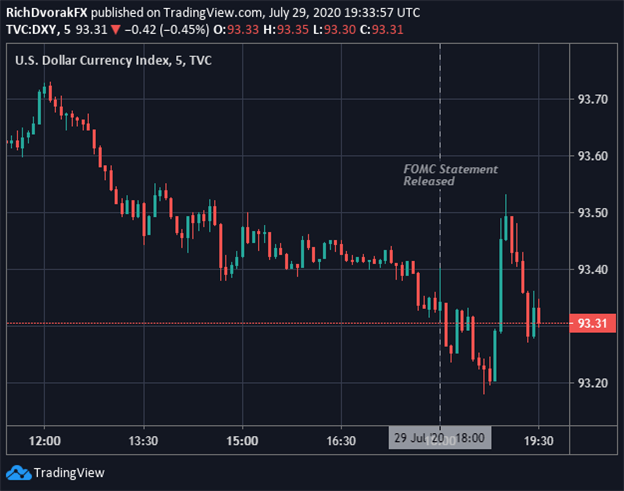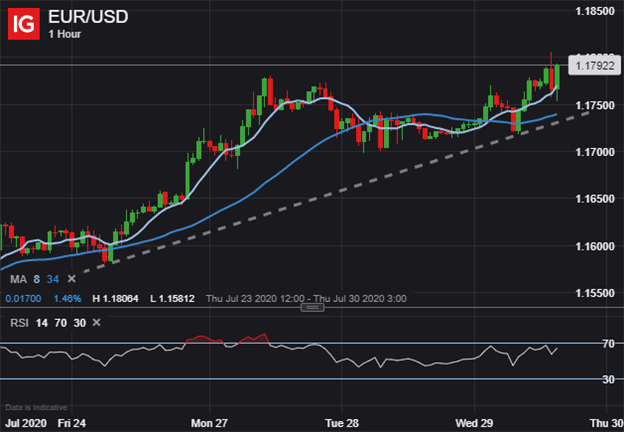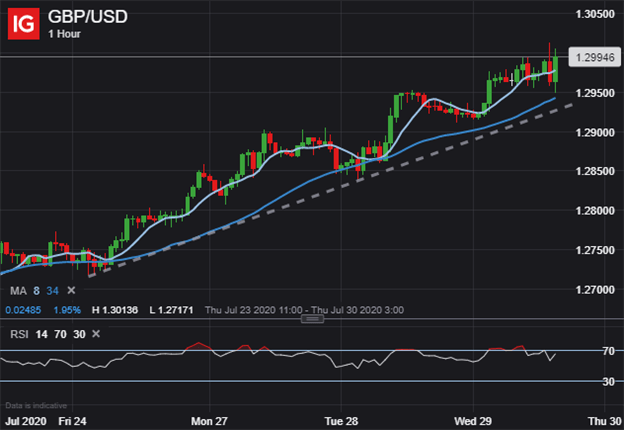US Dollar Weakness To Linger As Fed Extends USD Swap Lines
A sharply weaker US Dollar has garnered quite a bit of attention from market participants over recent trading sessions. The DXY Index, a broad basket of top currency pairs, is pacing a big drop for July and the latest Fed meeting looks to emphasize US Dollar selling pressure.
This follows word from FOMC officials who agreed to extend US Dollar currency swaps with other major central banks until March 31, 2021. The Federal Reserve extending FX basis swaps looks to continue alleviating strains on US Dollar funding costs introduced at the onset of the global coronavirus pandemic.
DXY INDEX – US DOLLAR PRICE CHART: 5-MINUTE TIME FRAME (29 JULY 2020 INTRADAY)
(Click on image to enlarge)

Chart created by @RichDvorakFX with TradingView
The Greenback extended lower immediately after the FOMC statement crossed the wires and into the follow-up press conference from Fed Chair Powell. The head central banker echoed a need for a prolongment of accommodative monetary policy measures due to the considerable risk that COVID-19 still poses to the economic outlook over the medium-term.
As Fed Chair Powell was delivering his speech and answering questions, the US Dollar suddenly began to spike higher but quickly drifted back lower. The move looked predominantly driven by short-lived profit taking by Euro and Sterling bulls.
EUR/USD PRICE CHART: 1-HOUR TIME FRAME (23 JULY TO 29 JULY 2020)
(Click on image to enlarge)

EUR/USD price action ripped higher and pierced the 1.1800-handle as US Dollar weakness accelerated on the back of the FOMC decision. After flirting with this psychologically-significant barrier of technical resistance, spot EUR/USD surrendered some of those gains, though the Euro held its short-term 8-hour moving average and remains notably higher on the day.
GBP/USD PRICE CHART: 1-HOUR TIME FRAME (23 JULY TO 29 JULY 2020)
(Click on image to enlarge)

The cable staged a similar reaction with GBP/USD price action ripping then dipping then recovering in the wake of the FOMC and Fed Chair Powell. After briefly eclipsing the 1.3000-price level, the Pound-Dollar slipped about 50-pips from its intraday. The move lower subsided as spot GBP/USD probed the 1.2950-mark with the major currency pair bouncing back towards session highs.
Looking forward, there is potential for the US Dollar to continue its bearish trend with the Fed committed to keeping financial conditions loose as the economy attempts to recover from the sharpest decline expected in GDP growth on record. Perhaps lower Treasury yields, which likely follows sustained Fed asset purchases of Treasuries, in addition to lower measures of expected market volatility suggested by the S&P 500 VIX ‘fear-gauge’, could underscore the current-standing bearish USD narrative.




If you want to see the US go lower cut out stimulus checks and watch the economy sink. It may happen with the Republicans and Trump trying to get a gold bug in the Federal Reserve. I guess he's not planning on winning.